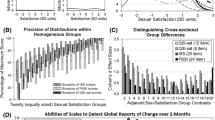Abstract
The coorientation method is used rarely to studycommunication in sexual dyads or other relationships dueto uncertainty regarding the optimal way to calculatekey variables (i.e., understanding, agreement, and perceived agreement). We examined thismatter empirically, assessing sexual coorientation among76 cohabiting couples; 152 adults completed measures oftheir own and their partners' sexual preferences as well as sexual satisfaction. Three sets ofsexual preference coorientation variables werecalculated using correlational, difference score, andcombined approaches. These variables were thencorrelated with the sexual adjustment measures todetermine which coorientation approach had greaterexplanatory power across several hypothesizedrelationships. Results clearly favored the correlationalmethod. We identify several potential applications of thecoorientation method and provide guidelines for itsapplication to research on dyadicrelationships.
Similar content being viewed by others
REFERENCES
Bentler, P. M. (1968a). Heterosexual behavior–I. Males. Behav. Res. Ther. 6: 21-25.
Bentler, P. M. (1968b). He terosexual behavior–II. Females. Behav. Res. Ther. 6: 27-30.
Chaffee, S. H. (1973). Applying the interpersonal perception model to the real world: An introduction. Am. Behav. Sci. 16: 465-468.
Cronbach, L. J. (1955). Processes affecting scores on "understanding of others" and "assumed similarity. " Psychol. Bull. 52: 177-193.
Cronbach, L. J., and Gleser, G. C. (1953). Assessing similarity between profiles. Psychol. Bull. 50: 456-473.
Fisher, T. D. (1993). A comparison of various measure s of family sexual communication: Psychometric properties, validity, and behavioral corre lates. J. Sex Res. 30: 229-238.
Frank, E., Anderson, C., and Rubinstein, D. (1978). Frequency of sexual dysfunction in "normal" couples. New Engl. J. Med. 299: 111-115.
Frank, E., Anderson, C., and Rubinstein, D. (1980). Marital role ideals and perception of marital role behavior in distressed and nondistressed couples. J. Marital Fam. Ther. 6: 55-63.
Hudson, W. W., Harrison, D. F., and Crosscup, P. C. (1981). A short-form scale to measure sexual discord in dyadic relationships. J. Sex Res. 17: 157-174.
Kaplan, H. S. (1974). The New Sex Therapy: Active Treatment of Sexual Dysfunctions. Times Books, New York.
Kilmann, P. R., Mills, K. H., Caid, C., Bella, B., Davidson, E., and Wanlass, R. (1984). The sexual interaction of women with secondary orgasmic dysfunction and their partners. Arch. Sex. Behav. 13: 41-49.
Kenny, D. A., and Acitelli, L. K. (1994). Measuring similarity in couples. J. Fam. Psychol. 8: 417-431.
Leiblum, S. R., and Rosen, R. C. (1979). The weekend workshop for dysfunctional couples: Assets and limitations. J. Sex Marital Ther. 5: 57-69.
LoPiccolo, J., and Friedman, J. M. (1988). Broad-spectrum treatment of low sexual desire: Integration of cognitive, behavioral, and systemic therapy. In Leiblum, S. R., and Rosen, R. C. (eds.), Sexual Desire Disorders, Guilford, New York, pp. 313-347.
LoPiccolo, J., and Steger, J. (1974). The Sexual Interaction Inventory: A new instrument for assessment of sexual dysfunction. Arch. Sex. Behav. 3: 585-595.
McLeod, J. M., and Chaffee, S. H. (1973). Interpersonal approaches to communication research. Am. Behav. Sci. 16: 469-499.
Nathan, E. P., and Joanning, H. H. (1985). Enhancing marital sexuality: An evaluation of a program for the sexual enrichment of normal couples. J. Sex Marital Ther. 11: 157-164.
Newcomb, T. M. (1953). An approach to the study of communicative acts. Psychol. Rev. 60: 393-404.
O'Keefe, G. J. (1973). Coorientation variables in family study. Am. Behav. Sci. 16: 513-536.
Price, V., and Roberts, D. F. (1987). Public opinion processes. In Berger, C. R., and Chaffee, S. H. (eds.), Handbook of Communication Science, Sage, Newbury Park, pp. 781-816).
Purnine, D. M., and Carey, M. P. (1997). Interpersonal communication and sexual adjustment: The roles of understanding and agreement. J. Consult. Clin. Psychol. 65: 1017-1025.
Purnine, D. M., and Carey, M. P. (1998). Age and gender differences in sexual behavior pre ferences: A follow-up report. J. Sex Marital Ther. 24: 27-36.
Purnine, D. M., Carey, M. P., and Jorgensen, R. S. (1994). Gender differences regarding preference s for specific heterosexual practices. J. Sex Marital Ther. 20: 271-287.
Purnine, D. M., Carey, M. P., and Jorgensen, R. S. (1996). The Inventory of Dyadic Heterosexual Preferences: Development and psychometric evaluation. Behav. Res. Ther. 34: 375-387.
Purnine, D. M., Carey, M. P., and Jorgensen, R.S.(1998). Inventory of Dyadic He terosexual Preferences and Inventory of Dyadic Heterosexual Preferences-Other. In Davis, C. M., Yarber, W. L., Bauserman, R., Schreer, G., and Davis, S. L. (eds.), Sexually-Related Measures: A Compendium. Sage, Thousand Oaks, CA.
Ross, J. L., Clifford, R. E., and Eisenman, R. (1987). Communication of sexual preferences in married couples. Bull. Psychonom. Soc. 25: 58-60.
Rubin, R. B., and Graham, E. E. (1994). Measures of interpersonal communication. In Rubin, R. B., Palmgreen, P., and Sypher, H. E. (eds.), Communication Research Measures: A Sourcebook, Guilford, New York, pp. 21-36.
Schneider, D. J., Hastorf, A. H., and Ellsworth, P. C. (1970). Person Perception, London. Addison-Wesley.
Stata Corporation. (1995). Stata Statistical Software: Release 4.0, Stata Corporation, College Station, TX.
Steeves, H. L. (1984). Developing coorientation measures for small groups. Commun. Monogr. 51: 185-192.
Talmadge, L. D., and Talmadge, W. C. (1986). Relational sexuality: An understanding of low sexual desire. J. Sex Marital Ther. 12: 3-21.
Verhulst, J., and Heiman, J. R. (1988). A systems perspective on sexual desire. In Leiblum, S. R., and Rosen, R. C. (eds.), Sexual Desire Disorders, Guilford, New York, pp. 243-267.
Wackman, D. B. (1973). Interpersonal communication and coorientation. Am. Behav. Sci. 16: 537-550.
Wincze, J. P., and Carey, M. P. (1991). Sexual Dysfunction: A Guide for Assessment and Treatment. Guilford, New York.
Rights and permissions
About this article
Cite this article
Purnine, D.M., Carey, M.P. Dyadic Coorientation: Reexamination of a Method for Studying Interpersonal Communication. Arch Sex Behav 28, 45–62 (1999). https://doi.org/10.1023/A:1018741605446
Issue Date:
DOI: https://doi.org/10.1023/A:1018741605446



